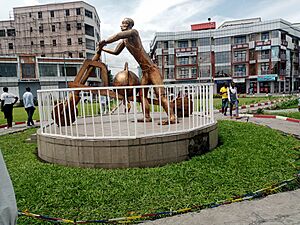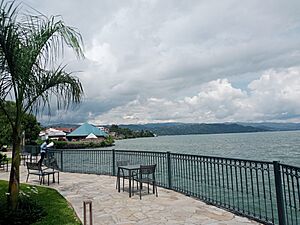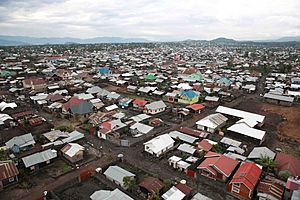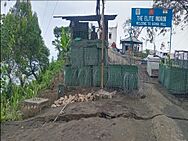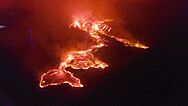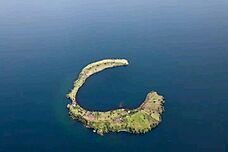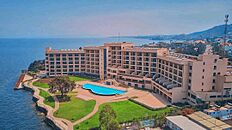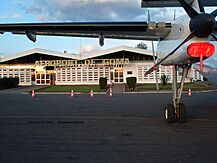Goma facts for kids
Quick facts for kids
Goma
|
|
|---|---|
|
Provincial capital and city
|
|
| Ville de Goma | |
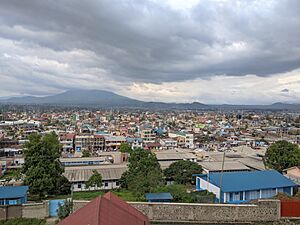
Goma, November 2022
|
|
| Country | DR Congo |
| Province | North Kivu |
| Communes | Goma, Karisimbi |
| Area | |
| • City | 75.72 km2 (29.24 sq mi) |
| Population | |
| • Metro | 670,000 |
| Time zone | UTC+2 (CAT) |
| National language | Swahili |
| Climate | Aw |
Goma is a major city and the capital of the North Kivu Province in the eastern part of the Democratic Republic of the Congo. It sits on the northern shore of Lake Kivu and is close to the active volcano Mount Nyiragongo, about 13 to 18 kilometers away. Goma is located in the Albertine Rift, which is part of the larger East African Rift.
The city covers about 75.72 square kilometers and has a population of nearly 2 million people, based on a 2022 count. Goma is divided into two main areas: Goma and Karisimbi. These areas are further split into 18 smaller "neighborhoods."
Goma is home to important places like Goma International Airport and the UNESCO World Heritage Site Virunga National Park. It is also surrounded by the Virunga Mountains, which include several volcanoes like Nyamulagira and Nyiragongo. The city also has universities, such as the University of Goma.
In recent times, Goma has faced challenges from volcanic eruptions and conflicts, including the First Congo War and Second Congo War. These events have had a lasting impact on the city. Despite these difficulties, Goma hosts the annual Festival Amani, which celebrates peace and attracts thousands of people.
Contents
What's in a Name?
The name Goma might come from the ngoma drum, which is used in traditional dances in parts of Africa. In some languages, ngo can mean "strength of the panther," and ma means "to give."
Goma's Location and Landscape
Goma is the largest city and capital of the North Kivu Province in eastern Democratic Republic of the Congo. It is bordered by different areas: Nyiragongo Territory to the north, Republic of Rwanda to the east, Lake Kivu to the south, and Masisi Territory to the west.
The city is built on a flat area made of volcanic lava, which gently slopes towards Lake Kivu. This plain is surrounded by the Virunga Mountains, home to famous volcanoes like Nyamulagira and Nyiragongo. The northern part of the plain is quite high, between 1,640 and 2,000 meters above sea level. Nyiragongo volcano has been active for a long time, with a lava lake and eruptions in 1977, 2002, and 2021.
Goma's land is mostly volcanic, with some sandy soil. The ground is covered with basalt rocks. There are also hills like Mount Goma, Mount Ndosho, and Mount Mugunga. Mount Goma is an old, inactive volcano near the public port.
The city's plant life is mostly savannah with some bushes. People have also planted many trees to make the city look nicer and help control temperatures. Goma gets its water from Lake Kivu and smaller lakes like Green Lake and Black Lake.
Goma's Climate
Goma has a tropical savanna climate, which means it has warm days and pleasant nights all year. Because the city is high up, its climate is milder than other places at the same latitude.
| Climate data for Goma | |||||||||||||
|---|---|---|---|---|---|---|---|---|---|---|---|---|---|
| Month | Jan | Feb | Mar | Apr | May | Jun | Jul | Aug | Sep | Oct | Nov | Dec | Year |
| Mean daily maximum °C (°F) | 25.6 (78.1) |
25.7 (78.3) |
25.7 (78.3) |
25.4 (77.7) |
25.3 (77.5) |
25.3 (77.5) |
25.2 (77.4) |
25.8 (78.4) |
25.9 (78.6) |
25.7 (78.3) |
25.3 (77.5) |
25.4 (77.7) |
25.5 (77.9) |
| Daily mean °C (°F) | 20.0 (68.0) |
20.1 (68.2) |
20.1 (68.2) |
20.0 (68.0) |
19.9 (67.8) |
19.4 (66.9) |
19.7 (67.5) |
19.8 (67.6) |
19.8 (67.6) |
19.9 (67.8) |
19.7 (67.5) |
19.9 (67.8) |
19.9 (67.7) |
| Mean daily minimum °C (°F) | 14.4 (57.9) |
14.6 (58.3) |
14.6 (58.3) |
14.7 (58.5) |
14.6 (58.3) |
13.6 (56.5) |
13.1 (55.6) |
13.9 (57.0) |
14.0 (57.2) |
14.2 (57.6) |
14.1 (57.4) |
14.4 (57.9) |
14.2 (57.5) |
| Average rainfall mm (inches) | 94 (3.7) |
84 (3.3) |
117 (4.6) |
119 (4.7) |
108 (4.3) |
55 (2.2) |
29 (1.1) |
70 (2.8) |
117 (4.6) |
143 (5.6) |
138 (5.4) |
118 (4.6) |
1,192 (46.9) |
| Average rainy days | 16 | 16 | 19 | 22 | 18 | 8 | 6 | 8 | 15 | 20 | 22 | 19 | 189 |
| Mean daily sunshine hours | 5 | 5 | 5 | 5 | 5 | 6 | 7 | 5 | 5 | 5 | 5 | 5 | 5 |
| Source 1: Climate-Data.org, altitude: 1,531 metres or 5,023 feet | |||||||||||||
| Source 2: Weather2Travel for rainy days and sunshine | |||||||||||||
City Divisions: Communes and Quarters
Goma covers about 75.72 square kilometers. Its population has grown from 80,000 in 1984 to nearly 2 million in 2022. The city is divided into two main areas, called communes or municipalities: Goma and Karisimbi. These communes are then split into 18 smaller sections called quartiers, which are like neighborhoods.
This division was set up in 1989. Over time, as the population grew, some quartiers were divided into new ones to manage the density better. For example, Katoyi quartier was split into Kasika and Katoyi.
| Communes (municipalities) | Population
(2016) |
Quartiers (quarters) |
|---|---|---|
| Goma | 319,351 | The Volcanoes, Mikeno, Mapendo, Katindo, Himbi, Keshero, Lac Vert |
| Karisimbi | 622,105 | Kahembe, Katoyi, Majengo, Mabanga-Nord, Mabanga-Sud, Kasika, Murara, Virunga, Ndosho, Mugunga, Bujovu |
| Goma | 941,456 |
Goma's Past
| Historical population | ||
|---|---|---|
| Year | Pop. | ±% |
| 1950 | 5,000 | — |
| 1960 | 16,000 | +220.0% |
| 1970 | 49,000 | +206.2% |
| 1980 | 68,000 | +38.8% |
| 1990 | 111,000 | +63.2% |
| 2000 | 198,000 | +78.4% |
| 2010 | 355,000 | +79.3% |
| 2018 | 566,000 | +59.4% |
| 2019 | 599,000 | +5.8% |
| 2020 | 634,000 | +5.8% |
| 2021 | 670,000 | +5.7% |
Goma started as a small village called Ngoma. It was a busy port for lake travel and a trading point between Central Africa and the Indian Ocean. In 1894, an explorer named Gustav Adolf von Götzen passed through and recorded the village as Goma.
In 1906, officials set up a military outpost in Goma to watch over activities on Lake Kivu. Later, it became a civil office. By the mid-1900s, Goma grew into an important center for transporting farm products and building materials. In 1945, Goma became a state post and its population quickly grew to about 1,000 people by 1948.
Goma continued to grow and became the capital of North Kivu in 1951. During this time, the city was planned with separate neighborhoods for Europeans and local Congolese people. The European areas became the city center and wealthier parts, while the local areas became densely populated. In 1988, North Kivu became its own province, and Goma was named its capital.
1994 Refugee Movement
In 1994, many people from Rwanda moved to Zaire (now the Democratic Republic of the Congo). Between June and July 1994, about 10,000 to 12,000 people arrived in Goma every day. This created a huge challenge because there wasn't enough shelter, food, or water for everyone.
Soon after, a serious illness spread through the refugee camps near Goma, causing many deaths. Aid organizations worked to help, but the situation was very difficult.
Conflicts and Their Impact
From the mid-1990s, Goma and its surrounding areas faced several conflicts. The First Congo War started in 1996. Different groups fought, and many people had to leave their homes. Refugee camps near Goma were attacked, forcing people to move again. Roads were blocked, making it hard for people to escape. By the end of 1997, rebels took control of the capital city, Kinshasa, and the country was renamed the Democratic Republic of the Congo.
The Second Congo War began in 1998. Goma became a key battleground. A rebel group called the Congolese Rally for Democracy (RCD) took control of Goma with support from Rwanda. The city was cut off from the government for nearly three years. During this time, local groups formed to protect their communities. This war caused a huge loss of life and suffering for civilians. By 2003, peace talks began, and a peace agreement was reached.
Ongoing Challenges
Even after the peace agreements, Goma has continued to face conflict. In 2006, a military leader named Laurent Nkunda caused more fighting, leading to many people being displaced and seeking safety near Goma. Clashes between the national army and Nkunda's forces continued.
In 2012, a group called the M23 movement took control of Goma for ten days. During this time, there was chaos and looting, and daily life stopped. The government forces later retook the city.
As of 2022, ongoing clashes in North Kivu have forced over a million people to leave their homes. More than 600,000 of them have come to crowded camps on the edge of Goma. In early 2024, fighting near Sake, close to Goma, caused even more people to flee to the city. International forces, like those from the Southern African Development Community (SADC), have been sent to help bring peace and a ceasefire to the region.
Health Crises: Ebola and COVID-19
From 2018 to 2020, the Kivu Ebola epidemic affected the region. In July 2019, a person with Ebola traveled to Goma, causing concern. Rwanda's Health Minister even announced that students would stop attending school in Goma due to the outbreak.
The COVID-19 pandemic in the Democratic Republic of the Congo also impacted Goma. The Amani Festival was canceled in 2021 but returned in February 2022.
Volcanoes and Earthquakes
Goma is located in the Great Rift Valley, where the Earth's plates are pulling apart. This causes frequent earthquakes and the formation of new volcanoes. Volcanic eruptions have directly affected Goma many times, with lava flows destroying villages, neighborhoods, and roads.
2002 Nyiragongo Eruption
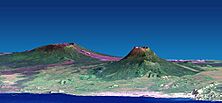
In January 2002, Nyiragongo volcano erupted. A wide stream of lava, up to a kilometer wide, flowed through the center of Goma all the way to Lake Kivu. Luckily, agencies watching the volcano gave a warning, and most people in Goma were able to evacuate to Gisenyi.
The lava destroyed 40% of the city, including over 4,500 houses and buildings. Some people died from the lava or from carbon dioxide gas, which can cause asphyxiation. The lava also covered part of the Goma International Airport runway. You can still see the lava in satellite pictures, and planes use the part of the runway that was not covered.
2021 Nyiragongo Eruption
On May 22, 2021, Mount Nyiragongo erupted again. Lava flows blocked a road and reached the city airport. The Buhene neighborhood was covered in cooling lava, destroying more than 500 homes. Parts of the city's electricity system were also destroyed.
Thousands of people fled to nearby areas. About 5,000 people crossed the border into Rwanda, and 25,000 went northwest towards Sake. The lava stopped flowing on May 30, 2021, and people began to return to Goma to check on their homes. Sadly, the United Nations Children's Fund reported that over 170 children were still missing. At least 15 people died from the eruption, including some in traffic accidents and others who were burned by lava.
2023 Nyamulagira Eruption
On May 9, 2023, lava was seen inside the main crater of Nyamulagira volcano. By May 17, a large glow was visible, and lava flowed into Virunga National Park. While these lava flows did not directly harm people, the volcano released large amounts of gas and fine particles. The heat over the crater increased, showing more lava was coming out, but it stayed at the top of the volcano. Satellite images showed that the eruption was releasing huge amounts of sulfur dioxide gas.
Danger from Lake Kivu
Lake Kivu is one of three lakes in Africa that holds a lot of dissolved gas deep underwater. If this gas is suddenly released, it can cause a "lake overturn," which is a catastrophic release of suffocating carbon dioxide. This has happened in other lakes, like Lake Nyos in 1986, which killed nearly two thousand people.
Lake Kivu is 2,000 times bigger than Lake Nyos and also contains dissolved methane, which is another danger. Nearly two million people, including those in Goma, live near Lake Kivu. They could be in danger if a nearby volcano or earthquake triggers a lake overturn.
Areas with high concentrations of CO2 gas, known as mazuku, have recently caused deaths of people and animals in the region.
Goma's Culture and Arts
Goma is the main cultural center of North Kivu. It has a lively entertainment and performing arts scene, including television, radio, theater, movies, and print. Like many cities in the DRC, Goma is known for its vibrant music, with popular styles like soukous, Congolese rumba, and Jazz. Many famous artists and public figures come from Goma.
Entertainment and Performing Arts
In the 1970s, theater was very popular in Goma, with many active theater groups performing at the Ciné Palace hall.
Goma is also a center for art and crafts. Skilled artists create beautiful wood carvings, pottery, textiles, and jewelry. The Foyer Culturel de Goma is the city's most important cultural center. It helps new talents like musicians, poets, actors, and visual artists grow. It also promotes local culture and art in North Kivu.
The city hosts the Festival Amani, a festival that brings together people from the African Great Lakes region and international artists to celebrate peace. Goma also has Yole! Africa, a youth cultural center that promotes peace through art, music, dance, and film.
Tourism in Goma
Even though Goma has faced challenges, especially during the conflicts in the late 1990s, it is still a popular place for tourists. The insecurity during those times caused tourism to decline, but it is now recovering.
Goma offers many attractions. You can visit national parks, mountains, and museums. Mount Nyiragongo, with its lava flows, is a unique sight. The Virunga National Park, just north of Goma, is home to over 3,000 different kinds of animals and plants. Tchegera Island, on Lake Kivu, is a beautiful place to visit.
Goma has many hotels, including the five-star Goma Serena Hotel, which offers luxury rooms, restaurants, and fitness centers. Other notable hotels include Hotel des Grands Lacs and Karibu Hotel. Besides hotels, Goma also has IT training centers, language schools, and customs agencies that help with trade.
Goma's Food
Goma's food shows the region's rich agriculture and different cultural influences. Common foods include cassava, plantains, maize, and rice. These are often served with different meats, fish, and vegetables. Popular local dishes include bugali (a starchy dough), sambaza (small dried fish that are often fried), and sombe (cassava leaves cooked in peanut sauce).
Mobile Networks and Media
Goma has several cellular network services, including SuperCell, Airtel, Vodacom, Orange RDC, and Tigo. These networks help people communicate locally and internationally, and they are important for business and social connections.
The city also has many radio stations that broadcast in Swahili, Lingala, and French. These stations offer news, entertainment, religious programs, and cultural content. Some popular stations include RTNC Goma, Radio Okapi, and Kivu 1.
Places of Worship
Goma has many Christian churches and temples, including those of the Roman Catholic Diocese of Goma, Kimbanguist Church, and various Baptist and Anglican churches. There are also Muslim mosques in the city.
Goma's Economy

Goma's economy mostly depends on agriculture. Many people work in trading agricultural products. Because the local money can be unstable, people often use foreign currencies for business. The main economic activities are farming, fishing, and hunting, often done using traditional methods.
Farm products come from nearby areas like Masisi and Rutshuru. Lake Kivu also provides fish, with busy fish markets twice a week. Farmers grow garden crops and main foods like legumes, maize, and tubers, using the rich volcanic soil. However, with so many people, Goma needs to find more ways to make money to ensure everyone has enough food.
The industrial sector, which changes raw materials into products, is smaller in Goma but has potential to grow. This is because the city has a large population, providing many workers. Some notable businesses include cigarette factories, coffee processing plants, bakeries, and water bottling facilities.
The service sector is the biggest part of Goma's economy. This includes public services, trade, education, healthcare, and law enforcement. The financial sector is very important, with banks and other financial groups serving the city's people. Banks like BCC and BPC provide financial services. There are also microfinance institutions that help people and small businesses get loans.
Organizations like UNDP also support businesses in Goma by offering training and resources. These groups help the city's economy grow and become more stable.
Getting Around Goma
Goma has different ways to travel: by air, by water, and by road.
Air travel is important for connecting Goma to other cities and countries. Goma International Airport handles both passengers and cargo. It has international flights to Entebbe and Nairobi, operated by Ethiopian Airlines and Jambojet. While some airlines have stopped flying to Goma, others like TMK and Wimbi Dira Airways continue to operate.
Maritime transport on Lake Kivu is also key. Boats and ferries connect Goma to nearby cities like Bukavu. Companies like SNCC and private operators move people and goods across the lake. Some boats, like Emmanuel 2, are even built locally, making travel faster than by road.
Road transport is used for getting around the city and to other cities. This includes trucks, buses, cars, and motorcycles. Goma is on the border with Rwanda, and you can easily travel by bus from Goma to Kigali, Rwanda's capital. City officials are working to improve road safety, especially for motorcycle taxis, by suggesting rules like wearing helmets.
Other Interesting Things About Goma
Goma is home to the Free University of the Great Lakes Countries, which helps with local development. The Goma International Airport also accepts charter flights. Goma has several wharves along Lake Kivu for boats. As of 2014, an art gallery opened in Goma, showing local woodcarving, painting, and puppets. Goma also hosts a Catholic priest seminary.
Many of Goma's roads were in poor condition for about 20 years, and some were badly damaged by lava flows. Since 2011, many roads have been rebuilt, mostly by Chinese companies. The city is being renovated by both public and private groups, as well as by MONUSCO (the UN peacekeeping mission).
In 2013, the United Nations Volunteers and MONUSCO organized a Tshukudu race in Goma. A Tshukudu is a unique wooden scooter used for transport in the region.
See also
 In Spanish: Goma (ciudad) para niños
In Spanish: Goma (ciudad) para niños



